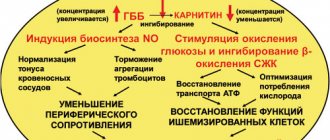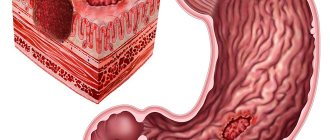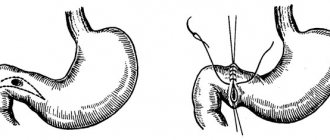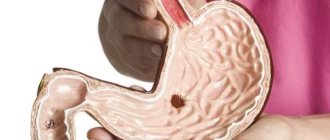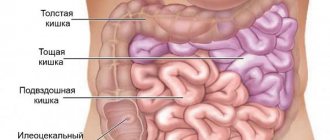An ulcer-like syndrome is observed in people suffering from a chronic form of erosion. It most often occurs in men, between 20 and 50 years of age. Similarities of diseases in the same erosive lesions of the stomach. Similar methods and medications are used for treatment and diagnosis.
The word erosion comes from the Latin language, erosio - erosion. When unwell, the cells of the mucous layer of the lining of the stomach and duodenum are damaged, but further layers are not affected. The concepts of erosion and ulcer are sometimes used as synonyms, due to their similarity, even generality. The diseases are similar, one can develop into another.
Minor differences
How is erosion different from a stomach ulcer? Damage to the upper, mucous layer in the first disease, and damage to the mucous layer, including the submucosal plate, in the second. In connection with the above, the second disease is characterized by regularly recurring relapse, long treatment times and scarring of the place where the ulcer was located. The process is explained by the presence of a transition from the acute to the chronic type, when after healing the ulcer leaves a scar.
Visual differences between lesions
Differences between stomach ulcers and erosion
An ulcer-like syndrome is observed in people suffering from a chronic form of erosion.
It most often occurs in men, between 20 and 50 years of age. Similarities of diseases in the same erosive lesions of the stomach. Similar methods and medications are used for treatment and diagnosis. The word erosion comes from the Latin language, erosio - erosion. When unwell, the cells of the mucous layer of the lining of the stomach and duodenum are damaged, but further layers are not affected. The concepts of erosion and ulcer are sometimes used as synonyms, due to their similarity, even generality. The diseases are similar, one can develop into another.
Diagnostics
If confirmation of the diagnosis of “erosive and ulcerative lesions of the stomach” is required, a gastroenterologist involved in the diagnosis and treatment of the disease will help. To confirm or refute the diagnosis, the patient undergoes esophagogastroduodenoscopy, popularly called gastroscopy. Performed on an empty stomach in an outpatient setting, the patient is required to swallow a narrow, flexible tube with an optical device - an endoscope. Using an endoscope, the gastroenterologist examines the walls of the esophagus, stomach and duodenum for erosions and ulcers, if necessary, takes a photograph of the area of interest and performs a biopsy (pinching off a piece of damaged tissue for careful analysis in the laboratory). The unpleasant procedure is carried out quickly and is absolutely painless.
As an additional diagnosis, a gastroenterologist may suggest an ultrasound and x-ray of the stomach.
Development mechanism
The cause of mucosal lesions is an imbalance between the protective mucus produced in the stomach and the aggressive effects of hydrochloric acid and pepsin, which are necessary for the digestion of food entering the body. In a slightly alkaline environment (i.e. when acidity is increased), not only food is digested, but also stomach tissue is destroyed.
The pathogenesis of the development of both processes is the same, but healing of erosions occurs faster. As a result of these factors, the process of destruction of mucosal cells begins in a certain area, and it loses its protective properties. As a result, a wound is formed - this is erosion. If you carry out therapeutic measures, the erosion will drag on. Otherwise, it will increase, deepen, penetrating, among other things, into the muscle layer - this is how an ulcer forms.
In pathologies, the protective layer of the stomach is damaged
Peptic ulcer disease is more dangerous than erosion and can cause complications, for example, the development of malignant tumors.
The most important process that provokes the development of erosions and gastric ulcers is the activation of Helicobacter pylori bacteria. These microorganisms cause multiple harm:
- their reproduction leads to the destruction of the mucous membrane;
- provoke an increase in the production of hydrochloric acid;
- development of the inflammatory process of the mucous membrane.
As a result, leukocytes migrate from the blood vessels to the site of inflammation, bringing with them reactive oxygen species, which damages the epithelial layer. The mucous membrane becomes more sensitive to irritating factors.
At the same time, the microorganisms themselves have adaptive mechanisms, thanks to which they can calmly exist in an environment with high acidity. In addition, Helicobacter pylori, in the process of its vital activity, produces toxins that have a destructive effect on the mucous membrane. The situation will be complicated if a person adheres to an unhealthy lifestyle.
As a result of the life activity of Helicobacter pylori, pathologies develop
Today, these bacteria are called the cause of damage to the gastric mucosa. The version in which the provoking factor is an increase in the production of hydrochloric acid has faded into the background. Therefore, the modern approach to treatment uses antibacterial drugs to suppress the activity of pathogenic microorganisms.
Symptoms
Erosive and ulcerative lesions of the stomach are not always characterized by severe symptoms. Such cases occur infrequently, common signs:
- Painful symptoms in the upper abdomen, and in some patients the intensity of pain is low, in others the pain is severe, intensified by drinking alcohol, spicy food, with long breaks between meals or playing sports.
- Heartburn is characterized by a burning sensation in the area just above the abdomen.
- Nausea, sometimes with vomiting, bringing relief.
- Decreased appetite.
- Belching with a bitter or acidic taste.
- Increased gas formation.
- Feeling of heaviness in the stomach after eating.
- Quick feeling of fullness.
- Various stool disorders.
Symptoms
Erosive gastritis is characterized by vivid symptoms:
- strong cutting pain;
- bleeding;
- blood in stool;
- vomiting with blood;
- dark stool color;
- bad and brittle nails;
- hair condition worsens;
- dry skin;
- violation of taste preferences;
- signs of anemia;
- problems with urination;
- nausea;
- heartburn;
- hunger pains;
- digestive disorders.
As you can see, the symptoms of erosion are similar to the symptoms of ulcers.
Return to contents
Forms of the disease
Erosive and ulcerative lesions of the stomach have two forms: acute and chronic; when working with a patient, the doctor must take this into account. The acute form is characterized by localization of pain at the bottom of the gastric wall, epithelium is not layered on the area of erosion, there is no fibrin, pain is more pronounced and appears more often. Painful symptoms of acute erosion correspond to the severe pain described above. The acute form is treated in two weeks.
In the chronic form, pain is localized at the junction of the stomach and the beginning of the duodenum. The pain is milder, less frequent, and treatment continues for up to six months. Depends on the strength and scale of the lesion, the perception of drugs by the patient’s body.
Types
- Hemorrhagic type (from Latin hema - blood). Such erosions reveal plaque in the form of blood and a pale, hyperemic, reddened membrane.
- Superficial flat - distinguished by a white rim around the erosion damage, there is a white coating, the inside is clean. There are exceptions.
- Full - similar in appearance to a polyp, most often formed in a fold of the gastric walls. Other names: hyperplastic, inflammatory.
Provoking factors
Unfortunately, doctors cannot determine exactly what causes erosion, but they know what factors contribute to the development of the disease. Risk factors include poor diet, smoking, inappropriate use of medications, especially anti-inflammatory drugs, alcohol abuse, and depression.
Stomach erosion in a patient
Identifying causes
Provided that gastric erosion is not an independent pathology, you will have to look for problems in other organs. Most often in the liver and blood vessels. The treatment is complex - to achieve the highest effect. During the process, endoscopy is required to monitor the results of therapy and correction.
The first thing the patient needs to know
Before starting treatment, you need to find out the cause of the disease, then treat it. Otherwise, in addition to the existing erosive and ulcerative lesions of the stomach, you can get additional ones. Such a disorder appeared due to incorrect functioning of the liver or kidneys. Therapy to normalize the functioning of organs is mandatory, otherwise the effect of therapy will drop to zero.
Basic diet rules
Diet in the treatment of erosion is necessary; without the right conditions for the functioning of the stomach, healing of the mucous membrane is impossible. The temperature of the food plays a significant role; only warm, not hot or cold food is suitable.
If there is a diagnosis of “stomach erosion,” too cold or, conversely, hot food injures the deep layers of the stomach lining, leading to aggravation of the diagnosis. In the absence of a painful condition, a healthy person feels only slight discomfort; the mucous membrane prevents injury to the stomach.
Is it possible to do without medications?
It is believed that by following a proper diet, it is possible to cure the disease without medication. According to the recommendations, meals should be taken frequently and regularly, every 3.5 or 4 hours, the portion should be 250 - 300 ml; with an increase in volume, aggravation of the diagnosis is quite expected.
What products would be good to include?
The eroded area of the stomach wall can be treated:
- Slimy porridges made from rice, oatmeal, millet and semolina are good.
- Kissels, compotes, herbal teas.
- Vegetables and fruits, not cabbage, not radishes.
- For meat, it is better to choose lean, boiled chicken and lean beef, no pork.
- Boiled fish, steamed.
- Butter and olive oils, freshly squeezed juices (orange juices are not allowed).
- Fermented milk with a low fat content.
- Puddings, soufflés, steamed cutlets, slimy and pureed soups, mashed potatoes.
An ulcer responds well to treatment with a similar list of products.
What foods are forbidden to eat?
You will have to completely abandon:
- Alcoholic drinks.
- Coffee and coffee drinks.
- Cabbage, chocolate and products containing dyes and preservatives.
- Smoked, salted, bee products are not allowed, although you can leave propolis, it has restorative properties. There is no difference in diet in the last point. Suitable for one diagnosis, suitable for another.
Treatment
Often the disease is caused by taking medications that harm the gastric mucosa. Antibiotics are rarely recommended by doctors. Only if an infection is detected in the patient’s body.
Finding the cause of the disease is the first stage
When a bacterial component of the disease, or Helicobacter pylori bacteria, is identified, a suitable treatment method and medications are selected: amoxicillin, metronidazole, omeprazole. The course of treatment lasts two weeks.
Second stage - re-check
After the end of the first course, the patient is re-checked by a doctor.
If the test result is negative for the presence of erosive and ulcerative lesions of the stomach, a new stage of treatment begins. During this period of time, the patient is prescribed antibiotics and antibacterial drugs.
Causes
Erosive gastritis is the reason that the protective layer is not able to perform its functions; it is destroyed from the negative effects of gastric juice. The intercellular space in the epithelial tissue expands, which makes the mucous membrane more prone to lesions.
Factors that can provoke an imbalance in the protective layer of the stomach:
- frequent stress;
- injuries;
- burns;
- sepsis;
- long-term therapy with non-steroidal drugs for inflammation;
- surgical intervention on the digestive organs;
- shock; Many factors can provoke the appearance of erosive gastritis
- smoking;
- diabetes;
- poisoning with heavy metals or other dangerous compounds;
- burn of the mucous membrane caused by alcoholic drinks or irritating foods;
- violation of metabolic processes;
- alcoholism;
- chronic diseases of the respiratory system, which causes the body to receive little oxygen;
- heart failure;
- diseases of the digestive system;
- Helicobacter;
- bowel or stomach cancer.
Return to contents




